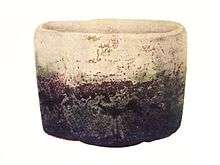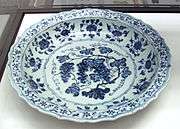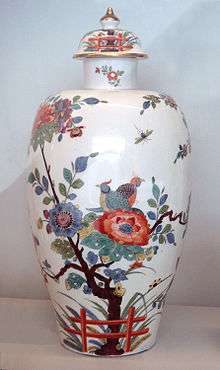Kutani ware
Kutani ware (九谷焼 Kutani-yaki) is a style of Japanese porcelain traditionally supposed to be from Kutani, now a part of Kaga, Ishikawa, in the former Kaga Province.[1] It is divided into two phases: Ko-Kutani (old Kutani), from the 17th and early 18th centuries, and Saikō-Kutani from the revived production in the 19th century. The more prestigious Ko-Kutani wares are recognised by scholars to be a complex and much mis-represented group, very often not from Kutani at all.
History
Ko-Kutani

The term kutani means "Nine Valleys". The first mention was in 1655 during the Meireki era. According to tradition, stones suitable for porcelain making were found in the Kutani mines of Daishoji clan. Gotō Saijirō, a member of the Maeda clan, was sent by orders of Lord Maeda Toshiharu of the Kaga domain to Arita in Hizen province to learn how to make porcelain.[2] He set up a kiln in the village of Kutani.[3] The lords of the Kaga domain became great patrons of Kutani. Porcelains from this early period are specifically called old Kutani (古九谷 ko-Kutani) and are very rare.[1][4] Ko-Kutani enjoyed popularity for the next few decades after 1655. The styles of the old Kutani were Aote (青手), which used colours of deep green, yellow, dark blue and purple, and Iroe (色絵), which used colours of red, green, purple, dark blue, and yellow.[5][6][7] Arita however also produced a number of vessels in the ko-Kutani style, as well as Kakiemon.[8][9]
Production suddenly closed down in 1730.[10] The reasons for this closure are debated.[5][11] Theories put forward include that supplies of the pigments necessary for the glazing were difficult to find, or that there were financial difficulties.[4] A memorial stone stele to Gotō was later erected near an old Kutani ware kiln in Kaga.
Saikō-Kutani
In 1804, respectively 1810, production was re-established with the help of several kamamoto, or production potters.[2][12] New overglaze painting techniques from various kamamoto were infused in the development of what became known as revised Kutani (再興九谷 saikō-Kutani). In the 19th century the style shifted to a more red design called aka-e (赤絵), which features intricate designs.[13] The gold technique is called kinran-de (金襴手), and the combination became aka-e kinran-de (赤絵 金襴手) Kutani.[12][14]
One of the first important exhibitions abroad was in 1873 at the Vienna World Exposition, where kinran-de was exhibited.[12] This helped spread its popularity and contributed to the export growth to Europe.[12] The style of producing Kutani was named a traditional craft in 1975.[3] There are now several hundred companies which produce Kutani ware.[1]
Many artists today are located in Komatsu, Ishikawa and Terai.[12] Well-known artists are Tatsuya Mitsui, Buzan Fukushima who specialises in aka-e, Takayama Kazuo (b. 1947) and Akaji Ken (b. in 1938) who work in the traditional style, and Tojiro Kitade and Fujio Kitade who work in the modern movement.[12][15] Tokuda Yasokichi III (1933–2009) was designated a Living National Treasure for his enamel work in ao-de ko-Kutani. Yoshida Minori (b. 1932) is a third generation master and specialises in the yūri-kinsai technique and was also designated a Living National Treasure.[15] Asakura Isokichi II (1913–1998) was also renowned and received the Order of Culture in 1996.[16][17]
Apart from traditional vessels such chawan, Kutani artists have also branched out in recent times to produce items such as a sneaker made out of porcelain with lively colours, and accessories such as USB flash drives.[18][19]
Characteristics
Kutani ware is marked by vivid dark colours that epitomise the lavish aesthetics. Is is theorised that the long, harsh and grey winters of the Hokuriku region led to a desire among people living there for ceramic ware to show strong and bold colours. The classical five colours style is known as gosai-de (五彩手) which includes green, blue, yellow, purple, and red. The designs are bold and normally depict landscapes, the beauty of nature, and people, and cover most of the surface of each piece.[3][4][11]
Six different overglazing techniques dominate the revised form of Kutani:
- Mokubei style, influenced by Chinese ink painting techniques[20]
- Yoshidaya style is marked by the colours of green, yellow, purple and dark blue as the basis[20]
- Eiraku style is in contrast to the Yoshidaya style, with its simplistic coatings of gold on the first coat of red colour[10][20]
- Iidaya style, or the Hachirode, breaks away from the conventional nature-themed Kutani style, with minute paintings of human figures on a red-gold aka-e kinran-de mix background[20][21]
- Shoza style is a blend of all four techniques of overglazing[10][20]
In a normal production process the artisan receives a plain white ceramic piece. The artisan will paint a komon (小紋) fine pattern, which is also shown on kimono. The outlines are painted with zaffre, which consists of cobald oxide. The vessel is then burned in the kiln, which turns the zaffre dark. It takes around seven hours to burn. The surface is then covered again in regular intervals. For the patterns and decoration, for example the five colours called gosai-de made out of vitreous enamel are painted on the vessel with thick strokes, making the whole piece more three-dimensional in the end. The ratio used in each glaze decides the specific tones of the colours. The vessel is then burned again in the kiln at 800 Celsius. The chemical reaction due to the heat turns the pigment into the translucent colours desired by the artisan. The paint changes into a transparent glass and the fine komon design gives it depth.[22]
Nowadays electric kilns are preferred since they reduce the error margin.
Fine calligraphy
A unique feature of Kutani ware is the application of fine calligraphy called saiji (細字) which is miniature in size. The founder of this art is considered to be Oda Seizan (小田清山), who first pioneered this form in the early Meiji era.[23] He wrote classical Chinese poems inside tea and sake cups with the thinnest brushes. By 1900 he also started writing in Japanese characters. Among his accomplishments were writing all poems of the Ogura Hyakunin Isshu inside a Western-style cup three centimetres in diameter, and 500 waka poems of the Meiji Emperor inside a Japanese teacup. His son-in-law Tamura Kinsei continued the craft and passed it on to his grandson Tamura Keisei 田村敬星 (b. 1949), who continues the art. He writes the calligraphy also on the outside of vessels such as incense burners. In 2005, he was designated an Intangible Cultural Property by the Ishikawa Prefecture government.[24][25]
References
- 1 2 3 "Kutani Ware: Background". Association for the Promotion of Traditional Craft Industries. Retrieved 2009-05-27.
- 1 2 Japanese Architecture and Art Net Users System. "JAANUS / kutaniyaki 九谷焼". Aisf.or.jp. Retrieved 2016-09-13.
- 1 2 3 "Kutani ware". Japan National Tourism Organization. Retrieved 2009-05-27.
- 1 2 3 "Kutani ware: Japanese porcelain". Encyclopædia Britannica. Retrieved 2009-05-27.
- 1 2 "The Birth of Kutani Porcelain: Kutaniyaki Art Museum". Kutani-mus.jp. Retrieved 2016-09-13.
- ↑ "Aote: Kutaniyaki Art Museum". Kutani-mus.jp. Retrieved 2016-09-13.
- ↑ "Iroe (Gosaite): Kutaniyaki Art Museum". Kutani-mus.jp. Retrieved 2016-09-13.
- ↑ "Plate | LACMA Collections". Collections.lacma.org. Retrieved 2016-09-13.
- ↑ 9–17. "Fles met een korte, nauwe hals, gedecoreerd met twee pauwen in veelkleurig email boven het glazuur., anoniem, ca. 1670 – ca. 1680 – Rijksmuseum". Rijksmuseum.nl. Retrieved 2016-09-13.
- 1 2 3 "Craftsman – master of Kutani wware". WAttention (Winter 2010, number 4): 16–17.
- 1 2 "Kutani Ware: The Rich Coloring of Magnificent Porcelain". Web Japan and the Ministry of Foreign Affairs. Retrieved 2009-05-27.
- 1 2 3 4 5 6 "Kutani Mino/History of Japanese pottery and porcelain". History-porcelain-japan.com. Retrieved 2016-09-13.
- ↑ "Revival of Kutani: Kutaniyaki Art Museum". Kutani-mus.jp. Retrieved 2016-09-13.
- ↑ "Akae (Kinrante): Kutaniyaki Art Museum". Kutani-mus.jp. Retrieved 2016-09-13.
- 1 2 "Kutani Porcelain as a Modern Art: Kutaniyaki Art Museum". Kutani-mus.jp. Retrieved 2016-09-13.
- ↑ "ASAKURA, Isokichi" (in (Japanese)). Shofu.pref.ishikawa.jp. 1998-04-09. Retrieved 2016-09-13.
- ↑ Georges C. BOUVIER (1913-02-26). "Asakura Isokichi history". Kutani.org. Retrieved 2016-09-13.
- ↑ "九谷焼×MADFOOT MADFOOT×日本酒|Project|JTP:JAPAN TRADITIONAL PROJECT~日本伝統文化を次世代へ、そして世界へ~". Japan-traditional.jp. Retrieved 2016-09-13.
- ↑ AAJ Editorial Team (2016-01-25). "5 Cool Products Merging Tech & Tradition". All About Japan. Retrieved 2016-09-13.
- 1 2 3 4 5 能美市九谷焼資料館. "Nomi Kutani Ceramics Museum│能美市九谷焼資料館" (in (Japanese)). Kutaniyaki.or.jp. Retrieved 2016-09-13.
- ↑ "An overview of Kutani Ceramics". G. Bouvier. Retrieved 30 April 2011.
- ↑ "5個組小鉢揃(3号) 梅小紋 [ 九谷焼 夏器 ] 九谷焼専門通販ショップ 九谷極彩 中田龍山堂". Kutani-gokusai.com. 2013-07-01. Retrieved 2016-09-13.
- ↑ "九谷焼 毛筆細字 陶窯田村 » What's Saiji ?". Saijitamura.main.jp. Retrieved 2016-09-13.
- ↑ "Japan Pottery Net / Artist's profile | TAMURA, Keisei". Japanpotterynet.com. Retrieved 2016-09-13.
- ↑ "Dialogue With Artists". Dai Ichi Arts. Retrieved 2016-09-13.
External links
| Wikimedia Commons has media related to Kutani ware. |


